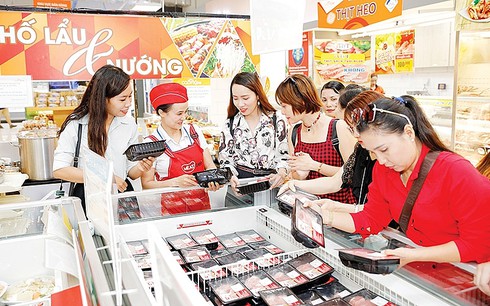taking both sides closer to enshrining the new basis for far tighter trade and investment ties.
 |
| The EVFTA will provide Vietnam with sure-fire advantages in terms of exports and diversifying import markets. Photo: Le Toan |
The Standing Committee last week green-lit legislators to vote on passing the EU-Vietnam Free Trade Agreement (EVFTA) and the EU-Vietnam Investment Protection Agreement (EVIPA), both a powerful source of trade and investment opportunities for both the EU and Vietnam, at the ninth session of the 14th National Assembly which will take place from May 20 to June 17.
Proposals delivered at the committee’s meeting by Minister, Chairman of State President Office Dao Viet Trung, Minister of Planning and Investment Nguyen Chi Dung, Minister of Industry and Trade Tran Tuan Anh, and the National Assembly’s Committee for Foreign Affairs all urged the National Assembly to adopt the EVFTA and the EVIPA at this session.
“The adoption of the agreements will help Vietnam strongly expand trade and investment relations with EU member states,” Minister Dung stated.
An expert from the Delegation of the European Union to Vietnam told VIR that all the work related to the adoption of the EVFTA has already been completed by the EU side.
Specifically, the Council of the European Union in late March adopted a decision on the conclusion of the deal and in mid-February, the European Parliament officially adopted the EVFTA and the EVIPA.
“Translation of the deals’ text into different languages has also been completed. Currently the EU side is waiting for the Vietnamese side to pass the deals. If everything goes smoothly in May, it is expected that the EVFTA will begin to take effect in July,” the expert said.
Meanwhile, the EVIPA will need to be ratified by all EU member states according to their respective national procedures before it can enter into force. Once ratified, it will replace the bilateral investment agreements that the 21 EU members states currently have in place with Vietnam
It is likely that the EU’s Commissioner for Trade Phil Hogan will in July pay a visit to Vietnam where he and Prime Minister Nguyen Xuan Phuc will jointly launch the EVFTA into force.
Right after that, 65% of export items from the EU into Vietnam will see import tariffs removed immediately. The items include electric goods and machinery, textiles and garments, aquatic products, and 50% of pharmaceuticals.
Meanwhile, import tariffs on 71% of items from Vietnam will also be removed immediately, such as unprocessed shrimp and rice (subject to quotas depending on varieties).
Import taxes for tra and basa fish – Vietnam’s staple exports – will be removed after three years. In five or seven years, the EU will erase taxes on all sensitive textile and garment items from Vietnam.
“Many businesses from the EU are eager to see tariff cuts in Vietnam, so that they can boost exports and investment in the Southeast Asian market,” the expert said.
Pham Thai Lai, president and CEO of Siemens ASEAN and Vietnam, told VIR the EVFTA is a great foundation to boost trade and more.
“In the coming years, I strongly believe that we can expect robust growth in investment from the EU to Vietnam and a substantial increase in exports from Vietnam to the EU,” Lai said.
According to him, FTAs offer Vietnam great advantages in terms of export, and at the same time help diversify its import markets. Not only can Vietnam benefit from significant tariff reduction but also from having ample opportunities to access and expand to new markets worldwide. Lai added that Vietnam’s demand for basic infrastructure is huge.
“I see enormous potentials in the areas of power generation, transmission and distribution, energy efficiency, and transportation,” he said.
Hogan also commented that the EVFTA has a huge economic potential.
“A win for consumers, workers, farmers and businesses. And it goes well beyond economic benefits. Once in force, these agreements will further enhance our potential to promote and monitor reforms in Vietnam,” he said.
According to the European Parliament, Vietnam is a booming, competitive and connected economy with almost 100 million citizens, a growing middle class and a young and dynamic workforce.
The country is also one of the fastest growing countries in ASEAN with average GDP growth rate of around 6.51% from 2000 until 2018. Moreover, Vietnam is also one of the most open and pro free trade economy in the region.
The EVFTA is expected to be a major driver of Vietnamese exports, and help Vietnam to diversify its markets and exports, especially its key staples such as agro-forestry-aquactic products, electronics, footwear, garments and textiles which are the country’s competitive advantages. Currently Vietnam’s exports rely on its traditional markets like China, the US, Japan, and the Republic of Korea.
According to the General Statistics Office, in 2019, EU member states spent US$41.7 billion on importing Vietnamese goods, capturing 15.8% of Vietnam’s total export turnover of US$263.45 billion. These markets also exported US$14.8 billion worth of goods to Vietnam, holding 5.8% of the country’s total import turnover of US$253.51 billion. VIR

Vietnam has high hopes for investments from Europe after EVFTA ratification
Vietnam is looking forward to receiving high-quality investments from Europe once the EU-Vietnam FTA (EVFTA) and the EU-Vietnam Investment Protection Agreement (EVIPA) take effect.

EVFTA to be submitted to 9th National Assembly session for approval
The National Assembly Standing Committee has agreed with a proposal of the President that the EU-Vietnam Free Trade Agreement and the EU-Vietnam Investment Protection Agreement will be submitted to the upcoming NA session for approval.
 The National Assembly Standing Committee has agreed to stage a vote on adoption of two hallmark bilateral trade and investment agreements between Vietnam and the EU,
The National Assembly Standing Committee has agreed to stage a vote on adoption of two hallmark bilateral trade and investment agreements between Vietnam and the EU,